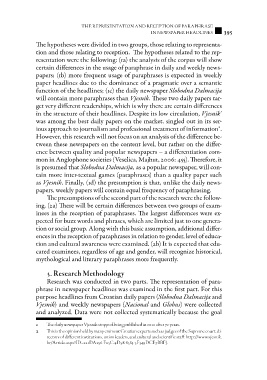Page 395 - Gabrijela Kišiček and Igor Ž. Žagar (eds.), What do we know about the world? Rhetorical and argumentative perspectives, Digital Library, Educational Research Institute, Ljubljana 2013
P. 395
the representation and reception of paraphrase
in newspaper headlines 395
The hypotheses were divided in two groups, those relating to representa-
tion and those relating to reception. The hypotheses related to the rep-
resentation were the following: (1a) the analysis of the corpus will show
certain differences in the usage of paraphrase in daily and weekly news-
papers; (1b) more frequent usage of paraphrases is expected in weekly
paper headlines due to the dominance of a pragmatic over a semantic
function of the headlines; (1c) the daily newspaper Slobodna Dalmacija
will contain more paraphrases than Vjesnik. These two daily papers tar-
get very different readerships, which is why there are certain differences
in the structure of their headlines. Despite its low circulation, Vjesnik1
was among the best daily papers on the market, singled out in its ser-
ious approach to journalism and professional treatment of information2.
However, this research will not focus on an analysis of the difference be-
tween these newspapers on the content level, but rather on the differ-
ence between quality and popular newspapers – a differentiation com-
mon in Anglophone societies (Veselica, Majhut, 2006: 455). Therefore, it
is presumed that Slobodna Dalmacija, as a popular newspaper, will con-
tain more inter-textual games (paraphrases) than a quality paper such
as Vjesnik. Finally, (1d) the presumption is that, unlike the daily news-
papers, weekly papers will contain equal frequency of paraphrasing.
The presumptions of the second part of the research were the follow-
ing. (2a) There will be certain differences between two groups of exam-
inees in the reception of paraphrases. The largest differences were ex-
pected for buzz words and phrases, which are limited just to one genera-
tion or social group. Along with this basic assumption, additional differ-
ences in the reception of paraphrases in relation to gender, level of educa-
tion and cultural awareness were examined. (2b) It is expected that edu-
cated examinees, regardless of age and gender, will recognize historical,
mythological and literary paraphrases more frequently.
3. Research Methodology
Research was conducted in two parts. The representation of para-
phrase in newspaper headlines was examined in the first part. For this
purpose headlines from Croatian daily papers (Slobodna Dalmacija and
Vjesnik) and weekly newspapers (Nacional and Globus) were collected
and analyzed. Data were not collected systematically because the goal
1 The daily newspaper Vjesnik stopped being published in 2012 after 72 years.
2 This is the opinion held by many eminent Croatian experts such as judges of the Supreme court, di-
rectors of different institutions, union leaders, and cultural and scientific staff. http://www.vjesnik.
hr/Article.aspx?ID=221DA256-F05C-4D98-8585-5F349DCE7BBF).
in newspaper headlines 395
The hypotheses were divided in two groups, those relating to representa-
tion and those relating to reception. The hypotheses related to the rep-
resentation were the following: (1a) the analysis of the corpus will show
certain differences in the usage of paraphrase in daily and weekly news-
papers; (1b) more frequent usage of paraphrases is expected in weekly
paper headlines due to the dominance of a pragmatic over a semantic
function of the headlines; (1c) the daily newspaper Slobodna Dalmacija
will contain more paraphrases than Vjesnik. These two daily papers tar-
get very different readerships, which is why there are certain differences
in the structure of their headlines. Despite its low circulation, Vjesnik1
was among the best daily papers on the market, singled out in its ser-
ious approach to journalism and professional treatment of information2.
However, this research will not focus on an analysis of the difference be-
tween these newspapers on the content level, but rather on the differ-
ence between quality and popular newspapers – a differentiation com-
mon in Anglophone societies (Veselica, Majhut, 2006: 455). Therefore, it
is presumed that Slobodna Dalmacija, as a popular newspaper, will con-
tain more inter-textual games (paraphrases) than a quality paper such
as Vjesnik. Finally, (1d) the presumption is that, unlike the daily news-
papers, weekly papers will contain equal frequency of paraphrasing.
The presumptions of the second part of the research were the follow-
ing. (2a) There will be certain differences between two groups of exam-
inees in the reception of paraphrases. The largest differences were ex-
pected for buzz words and phrases, which are limited just to one genera-
tion or social group. Along with this basic assumption, additional differ-
ences in the reception of paraphrases in relation to gender, level of educa-
tion and cultural awareness were examined. (2b) It is expected that edu-
cated examinees, regardless of age and gender, will recognize historical,
mythological and literary paraphrases more frequently.
3. Research Methodology
Research was conducted in two parts. The representation of para-
phrase in newspaper headlines was examined in the first part. For this
purpose headlines from Croatian daily papers (Slobodna Dalmacija and
Vjesnik) and weekly newspapers (Nacional and Globus) were collected
and analyzed. Data were not collected systematically because the goal
1 The daily newspaper Vjesnik stopped being published in 2012 after 72 years.
2 This is the opinion held by many eminent Croatian experts such as judges of the Supreme court, di-
rectors of different institutions, union leaders, and cultural and scientific staff. http://www.vjesnik.
hr/Article.aspx?ID=221DA256-F05C-4D98-8585-5F349DCE7BBF).


